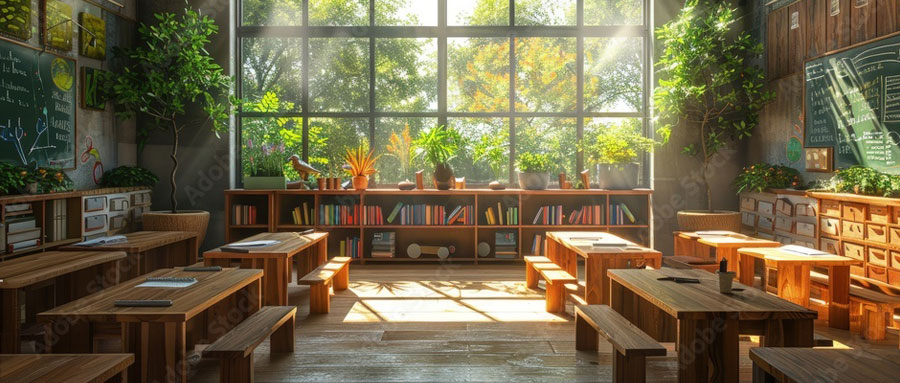
The concept of biophilic design, which integrates natural elements into built environments, is gaining traction in various fields, including education. This approach is based on the idea that humans have an innate connection to nature, and incorporating natural elements into learning spaces can significantly enhance student well-being and learning outcomes. This blog will delve into the principles of biophilic design, exploring how elements like plants, natural light, and nature-inspired textures can transform educational environments and foster a more effective learning experience.
Biophilic design is an innovative architectural approach that seeks to reconnect people with nature in the spaces where they live, work, and learn. The term "biophilia" was popularized by biologist Edward O. Wilson in the 1980s, who suggested that humans possess an inherent affinity for the natural world. By integrating natural elements into our environments, biophilic design aims to promote physical and psychological well-being.
Numerous studies have demonstrated the positive impact of biophilic design on human health and well-being. Research has shown that exposure to nature can reduce stress, improve mood, and enhance cognitive function. For students, these benefits translate into better concentration, higher academic performance, and improved overall well-being.
Natural light is one of the most important elements of biophilic design. It has been shown to have a profound impact on mood, productivity, and cognitive function.
Enhanced Mood and Energy Levels: Exposure to natural light helps regulate the body's circadian rhythms, which are responsible for sleep-wake cycles. This regulation leads to improved mood and energy levels, making students more alert and engaged during lessons.
Improved Academic Performance: Studies have shown that students in classrooms with ample natural light perform better on tests and assignments. A study by the Heschong Mahone Group found that students in classrooms with the most daylight progressed 20% faster in math and 26% faster in reading compared to those with the least daylight.
Reduced Stress and Anxiety: Natural light has a calming effect, reducing stress and anxiety levels. This creates a more relaxed learning environment, allowing students to focus better on their studies.
To maximize the benefits of natural light, schools can incorporate large windows, skylights, and glass doors in classroom design. Additionally, using light-colored walls and reflective surfaces can help distribute natural light more evenly throughout the space.
Incorporating plants into classroom spaces is a simple yet effective way to bring nature indoors. Plants not only enhance the aesthetic appeal of a classroom but also provide numerous health and cognitive benefits.
Improved Air Quality: Plants act as natural air purifiers, removing toxins and increasing oxygen levels. Better air quality can lead to improved concentration and reduced absenteeism due to respiratory issues.
Enhanced Cognitive Function: Research has shown that the presence of plants can enhance cognitive function and creativity. A study by the University of Exeter found that students in classrooms with plants showed a 15% improvement in cognitive performance.
Reduced Stress and Increased Well-Being: The presence of greenery has a calming effect, reducing stress and promoting a sense of well-being. This can create a more positive and conducive learning environment.
When selecting plants for classrooms, it's important to choose varieties that are low-maintenance and safe for children. Some suitable options include spider plants, peace lilies, and pothos. Regular care and maintenance, such as watering and pruning, should be incorporated into the classroom routine, providing an opportunity for students to learn about plant care and responsibility.
In addition to natural light and plants, incorporating nature-inspired textures and materials can further enhance the biophilic design of a classroom. These elements can create a tactile connection to nature, fostering a sense of comfort and well-being.
Enhanced Sensory Experience: Natural textures, such as wood, stone, and bamboo, provide a sensory experience that can enhance learning. These materials can create a warm and inviting atmosphere, making students feel more connected to their environment.
Improved Acoustics: Natural materials often have superior acoustic properties, helping to reduce noise levels and create a quieter learning environment. This can improve concentration and reduce distractions, leading to better academic performance.
Sustainability and Environmental Awareness: Using natural and sustainable materials in classroom design can teach students about environmental responsibility and the importance of sustainable practices.
Schools can incorporate natural textures and materials in various ways, such as using wooden furniture, stone accents, and bamboo flooring. Additionally, incorporating nature-themed murals and artwork can further enhance the biophilic design of the classroom.
Biophilic design isn't limited to the indoors. Creating outdoor learning spaces can provide students with direct access to nature, offering numerous educational and health benefits.
Increased Physical Activity: Outdoor learning encourages physical activity, which is essential for students' physical and mental health. It can also help improve focus and reduce behavioral issues.
Enhanced Engagement and Motivation: Learning in an outdoor setting can be more engaging and motivating for students. The natural environment provides a stimulating backdrop for hands-on learning and exploration.
Improved Social Skills: Outdoor learning often involves group activities, promoting teamwork, communication, and social interaction among students.
Outdoor classrooms can be designed to include features such as seating areas, natural shade, and garden beds. These spaces should be flexible and adaptable, allowing for various teaching methods and activities.
Incorporating biophilic design principles into classroom spaces offers numerous benefits for student well-being and learning outcomes. By integrating natural light, plants, nature-inspired textures, and outdoor learning spaces, educators can create environments that foster a deeper connection to nature and enhance the overall educational experience. As we continue to understand the importance of our natural surroundings, it becomes clear that bringing the outdoors inside is not just a trend, but a fundamental aspect of creating future-ready learning environments.